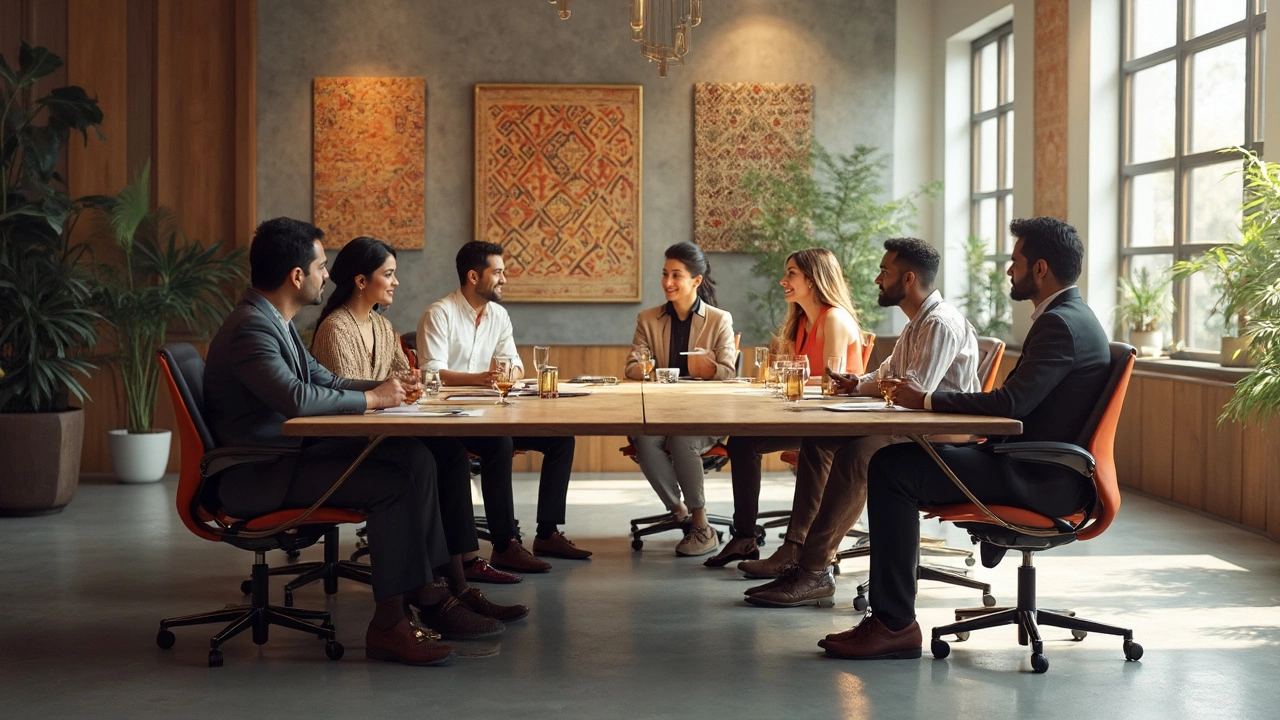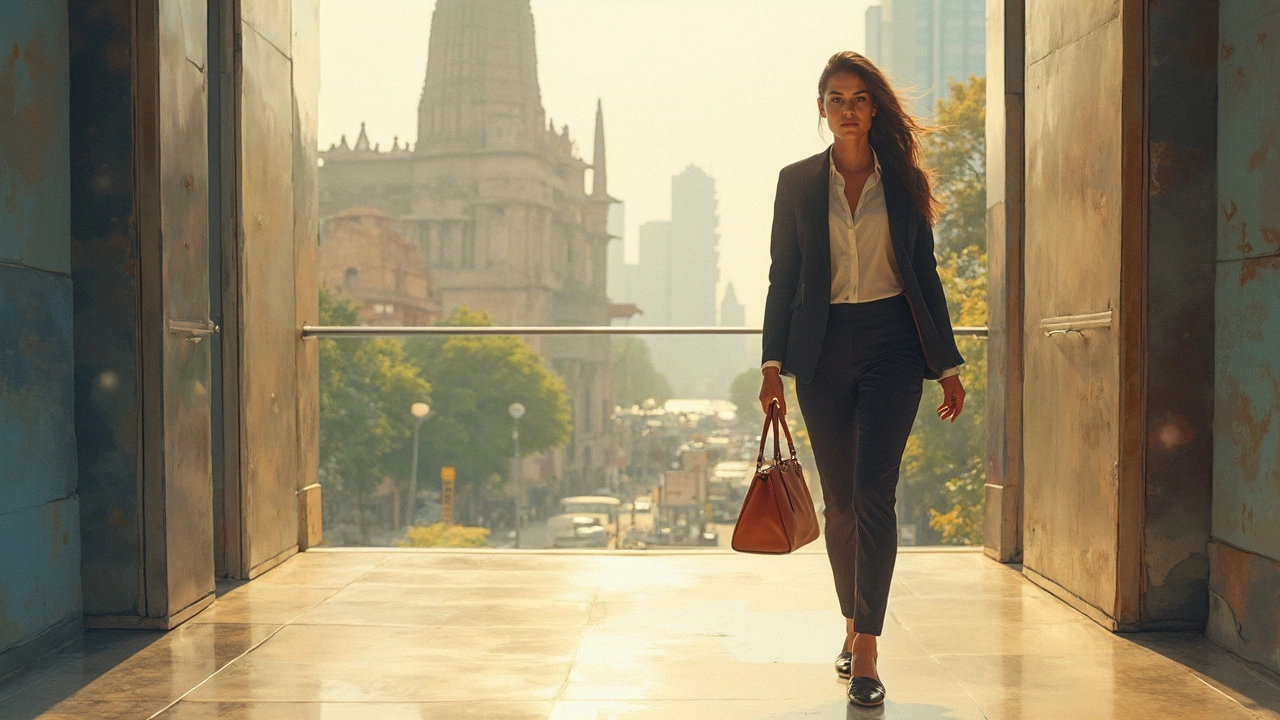Throwing on the right pair of shoes for work isn't as straightforward as it seems. Depending on whether you’re treading through the corporate jungle or stepping into a more laid-back creative space, the rules can vary dramatically.
Understanding your office's dress code policy is the first step. Corporate offices often lean towards formality, expecting polished leather shoes or neat loafers. But dive into a creative firm, and you might see sneakers strolling alongside those more traditional choices. The vibe totally shifts based on where you work.
And then there's the whole seasonal angle. No one wants to trudge through winter slush in their best leather loafers, right? Picking something practical yet professional is key.
But let’s not forget comfort and style. Whether you’re on your feet all day or sitting at a desk, choosing shoes that strike a balance between looking sharp and feeling good makes all the difference.
- Understanding Office Dress Codes
- Shoes for Corporate Offices
- Creative Workplaces and Their Flexibility
- Outdoor and Industrial Work Shoes
- Seasonal Considerations
- Comfort and Style Tips
Understanding Office Dress Codes
Alright, let's unravel this whole office dress code thing. It's not as stuffy as it sounds but knowing the basics can seriously help avoid awkward moments or HR's watchful eyes. Office environments vary widely, so understanding the specifics at your workplace is crucial to nailing down the proper work shoes.
Basics of Dress Codes
The first thing to check is whether your company has an official dress code policy, which is usually outlined in the employee handbook. Dress codes generally fall into a few categories: formal, business casual, casual, and the ever-popular, "smart casual." Each one comes with its own set of rules.
- Formal: Think suit-and-tie territory.
- Business Casual: A little more relaxed—like wearing khakis and a button-up.
- Casual: Often seen in tech environments, where jeans and sneakers fit right in.
- Smart Casual: It's a tricky mix of all the above, leaning more towards a neat yet relaxed look.
Shoes That Fit
For corporate offices with formal dress codes, aim for polished leather shoes or classic heels. If your office is on the business casual side, loafers, straightforward flats, or dress boots are safe bets. Creative or startup cultures might get away with well-kept sneakers or chic sandals, especially if they're paired with trendy or individualized attire.
"Your shoes are one of the key factors people use to analyze your professionalism," says Lucinda Labus, a leading expert in workplace attire. “Understand the guidelines, and then express your personal brand accordingly.”
When in Doubt, Ask
Don't hesitate to ask a colleague or your manager about what's appropriate if you're unsure. It might save you from learning the hard way. Plus, there might be room for flexibility or even certain 'sneaker days' if your workplace hosts casual Fridays!
Remember, the main goal is to strike a balance where your shoes both fit the workplace dress code and are something you can walk around in comfortably throughout the day.
Shoes for Corporate Offices
When it comes to corporate offices, the shoe game is all about striking that perfect balance between professionalism and comfort. The classic choice for men often includes polished leather shoes, like Oxfords or sleek loafers. If you're a woman, think about elegant pumps or stylish ballet flats—both offer a polished look without compromising comfort.
Choosing the Right Style
For men: Oxfords, Derby shoes, or brogues are timeless. If you’re going for loafers, ensure they're made from high-quality leather to last longer and look sharp.
For women: Kitten heels or block heels give a chic appearance while also being practical for a day's work. Just avoid anything too flashy or with high heels for everyday office wear.
Material Matters
Leather is the go-to material for the tailored appearance it brings. Apart from snagging polished looks, leather shoes usually boast durability. Just keep 'em away from water and make sure to care for them with regular polishing.
Colors and Patterns
Neutral colors like black, brown, navy, or nude tones are generally safe bets in office footwear. Want to add a little twist? Opt for subtle patterns or textures, but steer clear of anything too loud.
Customizing for Comfort
Making it through a workday with sore feet is a no-go. Investing in shoes with cushioned soles or removable insoles could save you a lot of hassle. If you’re up for it, arch support insoles are game changers, especially for shoes worn daily.
| Type | Ideal Use |
|---|---|
| Oxfords | Formal Meetings |
| Loafers | Everyday Office Wear |
| Kitten Heels | Long Office Hours |
| Ballet Flats | Commuting |
Picking the right footwear for the corporate office doesn't have to be overwhelming. Stick to these reliable styles, and you'll not only look the part but feel good doing it.
Creative Workplaces and Their Flexibility
Creativity isn’t just free-flowing ideas; it reflects in the way people dress, especially in creative workplaces. These environments, like ad agencies, design studios, and tech startups, often embrace individuality, and that includes your choice of work shoes.
Forget the stiff dress codes of the corporate world. Here, the unwritten rule seems to be: wear what lets you feel the most creative and comfortable. Need proof? Just take a look at some of the most successful tech companies—sneakers and even funky-colored loafers are a common sight.
Sneakers: The Creative Uniform
One of the biggest perks about working in a creative environment is the acceptance of sneakers. Whether for their comfort or style, they are often viewed as part of an unofficial creative uniform.
- Comfort: Long hours often require comfort without compromising your unique style.
- Style: Sneakers can range from minimalist to bold, letting employees express their personal taste.
Loafers, Boots, and More
Sneaker not your style? No worries! Loafers and versatile ankle boots also get a nod of approval. Like sneakers, these shoes offer a balance between personality and professionalism, especially in creative settings.
According to a survey I stumbled upon late last year, about 65% of employees in creative fields felt their productivity improved when they wore comfortable and expressive footwear.
For those in mixed-role environments—like client-facing creatives or those who hop between office and fieldwork—combining style with durability can be essential. Consider options that transition well, like leather sneakers or durable slip-ons.
Ultimately, when it comes to work footwear in a creative space, the key is putting together an ensemble that reflects your identity while still being practical. It's all about striking that balance between creativity and maintaining a professional image.

Outdoor and Industrial Work Shoes
When you’re working outdoors or in an industrial setting, your feet need protection, big time. It’s not just about looking the part but ensuring your footwear meets certain safety standards to keep your toes safe from all the hazards they might encounter.
The Importance of Safety Features
In most industrial workplaces, steel toe boots are practically a must. These boots are designed to withstand heavy impacts, perfect for construction or manufacturing sites where dropping a tool on your foot is more than possible. But it’s not just about the steel cap. Look for shoes with non-slip soles to prevent any unplanned floor kisses, especially in oily or wet settings.
Electrical hazard protection is another key feature. If you’re working with electricity, boots that offer insulation can protect you from unexpected shocks. They're kind of like your best friends when it comes to safety!
Material and Durability
Durability takes the front seat with materials like leather being popular due to their strength and ability to adapt to different environments. Waterproof boots? They’re lifesavers during those soggy, muddy shifts.
Weather Considerations
You can’t ignore the weather factor either. In cold areas, insulated boots keep your feet warm, while breathable ones save the day during hot summer months, preventing sweaty feet commotion.
Comfort Meets Functionality
Comfort doesn’t necessarily take a backseat to safety. Many brands now design work shoes that offer top-notch cushioning and arch support to keep your feet comfy even after hours of standing or walking. Pro tip: Breaking them in before you tackle a full day’s work can stave off blisters and other painful woes.
So, whether it's the latest composite toe tech or a classic steel toe, your outdoor and industrial work shoes should be up to the challenge, merging practicality with much-needed comfort.
Seasonal Considerations
As seasons change, so should your approach to work shoes. What keeps you dry and comfortable during one season could spell disaster in another.
Winter Woes
When winter hits, the last thing you want is soggy socks from tramping through snow in ill-equipped shoes. Opt for waterproof boots or leather shoes treated with a water-resistant coating. These choices ensure you stay warm and dry while still looking neat.
Don't forget about traction. Icy pavements can turn a simple walk into an extreme sport. Investing in shoes with good grip can be a real lifesaver.
Spring Showers
Spring can be tricky with its unpredictable showers. Having a pair of stylish yet functional rain boots tucked under your desk can save you from a midday soaking. Look for ones that can be easily slipped on over your pants on those suddenly wet mornings.
Summer Heat
Cue the shorts and breezy fabrics, but what about shoes? Closed-toe shoes that are breathable, like loafers or light canvas shoes, keep you cool and professional. It’s crucial to avoid flip-flops, no matter how tempting—most offices find them too casual.
Fall Fashion
Fall is that sweet spot where style and comfort meet. Ankle boots and brogues are office favorites, blending well with autumn colors. Make sure they're made of materials that can handle the occasional drizzle without leaving feet soggy.
By adjusting your office footwear with the seasons, you’ll stay comfortable and prepared no matter what Mother Nature throws at you.
Comfort and Style Tips
Let's talk about something crucial: comfort. It's tempting to slip style onto the top shelf, but when you're on your feet for hours, comfort is king. Trust me, your feet will thank you.
Choose the Right Fit
First up, always go for the perfect fit. That sounds basic, right? Well, it's amazing how many of us settle for shoes that are too tight or loose just because they look good. A well-fitting shoe should leave enough room in the toe box while snugly holding your heel. This simple consideration can prevent blisters and aches.
Look for Support
Avoid flats with no arch support. If you're planning on wearing flat shoes, try adding an ortho insert for comfort. For those in corporate offices where heels tower as a style norm, choosing a pair with thick heels or wedges enhances stability and eases the strain on your feet.
Materials Matter
Material plays a massive role in comfort. Breathable fabrics and leather help keep your feet cool, reducing sweat and odor. Want your work shoes to last while offering comfort? Genuine leather is durable and tends to mold to the shape of your foot, offering a personalized fit over time.
The Style Factor
Meeting dress codes doesn't mean ditching style. Sleek loafers, classic brogues, or smart sneakers can complement many work outfits without compromising on professional vibes.
- Sneakers can look sharp paired with well-fitted trousers in less formal settings.
- All-black or white leather sneakers often get away as ‘smart-casual’ for creative roles.
- Elegant designs like Oxford or Derby shoes are staples in most professional wardrobes.
Maintenance Hacks
Finally, maintaining your work shoes is important. Regular cleaning and conditioning, especially for leather, help keep them looking fresh. Rotate between pairs to allow shoes to air out and last longer.
